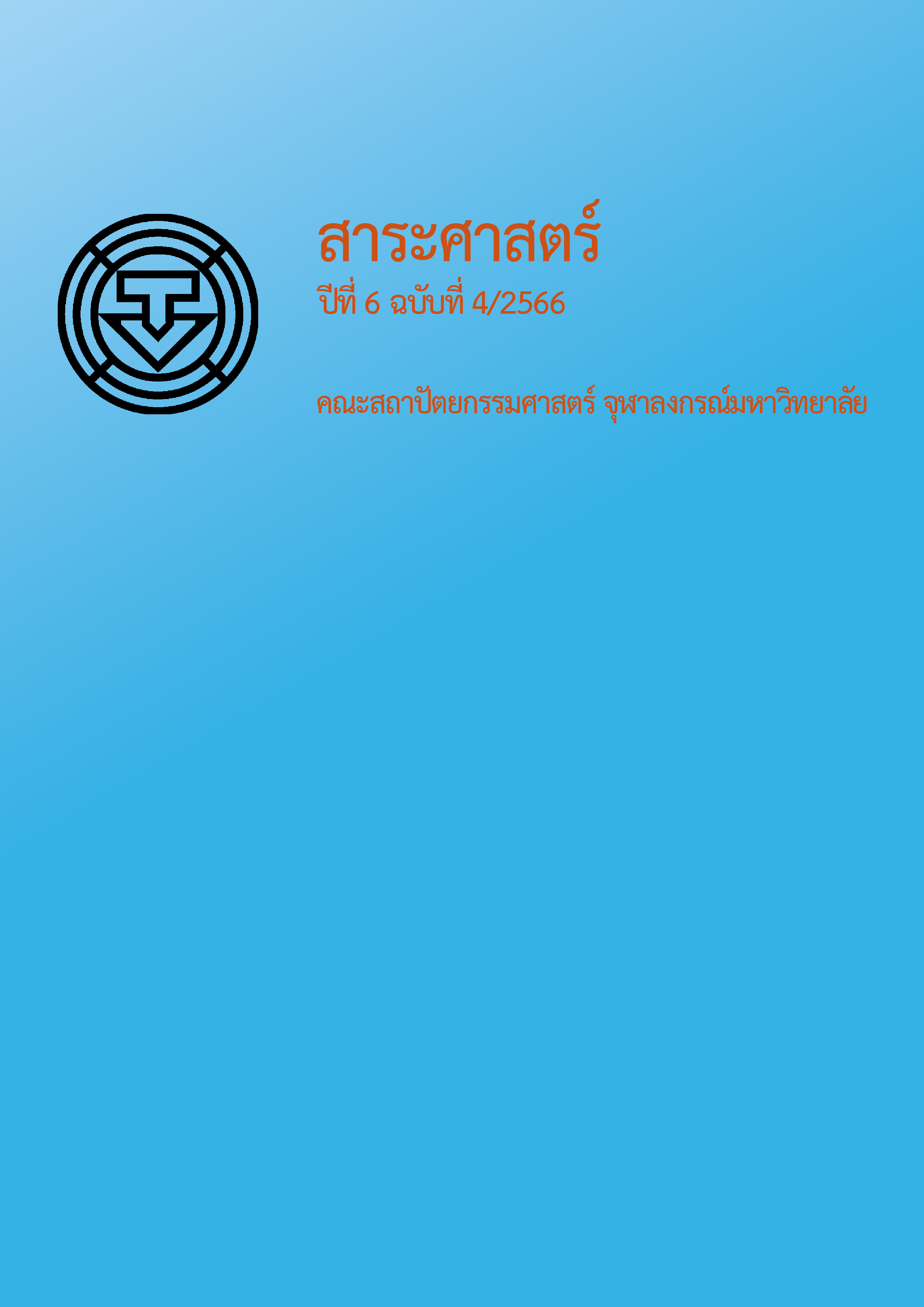Transit-Oriented Development (TOD) in accordance with a Cluster of Stations: a Case Study of BTS Skytrain Sukhumvit Line (The North)
Main Article Content
Abstract
BTS Skytrain Sukhumvit Line (The North) is a mass transit system running from Bangkok to suburban areas in the north, and the areas of Pathum Thani province. It is a mass transit system expected to help ease traffic congestion and increase travel speed while promoting the growth of urban areas as planned in the future to ensure the planning of transit-oriented development (TOD) is directional and consistent with physical environment of the surrounding areas. This research aimed to analyze physical factors of areas surrounding BTS stations to cluster stations according to relevant characteristics and to analyze major factors of each station cluster. According to the study, it was found that the analysis of the cluster of stations using hierarchical cluster analysis based on between-groups linkage could classify all 23 BTS stations into 4 major clusters consisting of 1) areas with education institutions and government offices, 2) areas with commercial buildings, 3) densely populated residential areas and central business districts and 4) places connecting to a mass transit system and public parks in urban areas. The analysis to identify major factors of each station cluster revealed that the major factor of the cluster 1 included usable areas of education institutions and the number of buildings of education institutions, the major factor of the cluster 2 was the number of commercial buildings and the number of population in the area, the major factor of the cluster 3 was usable areas in hotels, land prices and prices of condominiums, and the major factor of the cluster 4 included public park areas, and travel connecting points. The study results indicated characteristics of current areas in each station cluster that are expected to be useful for the planning of the development and improvement of land use for surrounding areas of each station to meet appropriateness and follow the guideline of the transit-oriented development (TOD)
Article Details
References
กุลจิรา สุขเกิดผล. (2561). ศึกษาการเปลี่ยนแปลงการใช้ประโยชน์ที่ดินในเส้นทางรายรอบรถไฟฟฟ้าสายสีน้ำเงิน [วิทยานิพนธ์ปริญญามหาบัณฑิต ไม่ได้ตีพิมพ์]. มหาวิทยาลัยธรรมศาสตร์.
ฉวีวรรณ เด่นไพบูลย์, ฮิเดะฮิโกะ คาเนกะเอะ, และปณต รัตนชุม. (2564). การศึกษารูปแบบการใช้ที่ดินแบบผสมผสานด้วยเครื่องมือการวิเคราะห์โครงข่ายเมืองบริเวณโดยรอบสถานีขนส่งระบบรางในกรุงเทพมหานคร. วารสารวิชาการการออกแบบสภาพแวดล้อม, 8(1), 101-125.
ณัฐพงศ์ ปัตตุล, พนกฤษณ คลังบุญครอง, ณัฐพจน์ ฝ่ายบุญ, ชาติชาย ไวยสุระสิงห์, สุรัตน์ ประมวลศักดิกุล, และมนสิชา เพชรานนท์. (2562). การคัดเลือกสถานที่เพื่อพัฒนาพื้นที่โดยรอบสถานี (TOD) ตามแนวเส้นทางระบบรถไฟฟ้ารางเบา (Light Rail Transit, LRT). วารสารวิจัย มข. (ฉบับบัณฑิตศึกษา), 20(2), 161-172.
ณัฐพล สุขแก้ว. (2558). การพัฒนาพื้นที่รอบสถานีรถไฟฟ้าตามแนวคิด TOD ในเขตพื้นที่กรุงเทพมหานคร [วิทยานิพนธ์ปริญญามหาบัณฑิต ไม่ได้ตีพิมพ์]. มหาวิทยาลัยเกษตรศาสตร์.
ถิรภาพ ฟักทอง, พิจิตรา ประภัสสรมนู, ปิยะวงศ์ ปัญจะเทวคุปต์, อติญา วงษ์วาท, กระจ่างศรี ศรีกระจ่าง ผสมทรัพย์, และจีรายุ ขอเชิญกลาง. (2565). แนวทางการพัฒนาพื้นที่รอบสถานีขนส่งมวลชน กรณีศึกษาสถานีรถไฟกรุงเทพ (หัวลำโพง). วารสารสิ่งแวดล้อมสรรค์สร้างวินิจฉัย คณะสถาปัตยกรรมศาสตร์ มหาวิทยาลัยขอนแก่น, 21(1), 135-149.
ทรงยศ อยู่สุข และวนารัตน์ กรอิสรานุกูล. (2558). การศึกษาการเปลี่ยนแปลงการใช้ประโยชน์ที่ดินโดยรอบสถานีรถไฟฟ้าอ่อนนุชและความสอดคล้องกับแนวคิดการพัฒนาพื้นที่รอบสถานีขนส่งมวลชน. วารสารสังคมศาสตร์ มหาวิทยาลัยศรีนครินทรวิโรฒ, 18(1), 66-82.
ทิติยา ทองสอง. (2558). การพัฒนาการใช้พื้นที่รอบสถานีรถไฟฟ้าใต้ดินสายเฉลิมรัชมงคลตามแนวคิด TOD [วิทยานิพนธ์ปริญญามหาบัณฑิต ไม่ได้ตีพิมพ์]. มหาวิทยาลัยเกษตรศาสตร์.
ธีระดา ภิญโญ. (2561). เทคนิคการแปลผลการวิเคราะห์องค์ประกอบสำหรับงานวิจัย. วารสารปัญญาภิวัฒน์, 10(1), 292-304.
ปฏิพล ยอดสุรางค์. (2562). ภัยคุกคามต่อลักษณะทางกายภาพของชุมชนเก่าริมน้ำในเขตที่ราบลุ่มน้ำเจ้าพระยา.วารสารวิชาการคณะสถาปัตยกรรมศาสตร์ สจล, 28(1), 21-34.
พนธกร อ่อนละมัย และเอกชัย ศิริกิจพาณิชย์กูล. (2565). การวิเคราะห์จัดกลุ่มตามลำดับชั้นและแยกประเภทสถานีรถไฟฟ้ากรณีศึกษา สถานีรถไฟฟ้ามหานครสายเฉลิมรัชมงคล. วารสารวิชาการพระจอมเกล้าพระนครเหนือ, 34(3), 1-12.
วรัลยา บำรุงพงศ์, พรรณี ชีวินศิริรัตน์, และเพชรพิไล ลัธธนันท์. (2564). ผลกระทบของรถไฟฟ้าบีทีเอส ต่อชุมชนในเขตบางนา. วารสารอักษรศาสตร์, 50(2), 101-124.
วิทยา ดวงธิมา และชาคริน เพชรานนท์. (2560). แนวทางการพัฒนาพื้นที่สาธารณะบริเวณรอบสถานีขนส่งมวลชนระบบราง. วารสารคณะสถาปัตยกรรมศาสตร์และการออกแบบสิ่งแวดล้อม มหาวิทยาลัยแม่โจ้, 8(1), 584-591.
สำนักการวางผังและพัฒนาเมือง. (2563). การนำมาตรการทางผังเมืองเชิงบวกมาใช้เพื่อพัฒนา TOD ในพื้นที่กรุงเทพมหานคร. http://www.thailandtod.com/wp-content/uploads/2020/08/มาตรการทางผังเมืองเชิงบวก-TOD.pdf
สำนักงานนโยบายและแผนการขนส่งและจราจร. (2553). โครงการศึกษาปรับแผนแม่บทระบบขนส่งมวลชนทางรางในเขตกรุงเทพมหานครและปริมณฑล. https://www.otp.go.th/uploads/tiny_uploads/PolicyPlan/1-PolicyPlan/M-MAP2/Report-MMAP-OTP.pdf
สำนักผังเมือง. กองวางผังพัฒนาเมือง. (2562). โครงการวางและจัดทำผังเมืองรวมกรุงเทพมหานคร (ปรับปรุงครั้งที่ 4). https://plan4bangkok.com
อภิญญา ผาดอน และภาวิณี เอี่ยมตระกูล. (2564). การจัดกลุ่มพื้นที่รอบสถานีขนส่งมวลชนระบบราง ตามคุณลักษณะสถานีด้วยแนวคิด Transit Oriented Development (TOD) กรณีศึกษารถไฟฟ้าสายสีเขียว (หมอชิต-อ่อนนุช) และรถไฟฟ้าสีน้ำเงิน (บางซื่อ-หัวลำโพง). วารสารวิชาการพระจอมเกล้าพระนครเหนือ, 31(3), 587-596.
Burns, N., & Grove, S. K. (1993). The practice of nursing research: Conduct, critique, & utilization (4th ed.). W. B. Saunders.
Calthorpe Associate. (1993). Transit-oriented development design guidelines: City of San Diego. http://www.sandiego.gov/planning/documents/pdf/trans/todguide.pdf
Institute for Transportation and Development Policy [ITDP]. (2014). Principles for transport in urban life. https://www.itdp.org/principles-for-transport-in-urban-life
Peterson, P. (2016). Rail and reinvention: Catalyzing transit-oriented development in Denver. http://www.confluence-denver.com/features/tod_denver_051816.aspx
Reusser, D. E., Loukopoulos, P., Stauffacher, M., & Scholz, R. W. (2008). Classifying railway stations for sustainable transitions – balancing node and place functions. Journal of Transport Geography, 16(3), 191-202.
Rui Wang, Nan Chen, & Chen Zhang. (2018). Clustering subway station arrival patterns using weighted dynamic time warping. https://thuie-isda.github.io/files/IEEM2018.pdf
Xin Zhao, Ya-peng Wu, Gang Ren, Kang Ji, & Wen-wen Qian. (2019). Clustering analysis of ridership patterns at subway stations: A case in Nanjing, China. Journal of Urban Planning and Development, 145(2).


